two Wayfarers spend two weeks sailing east from Hyères in Sept. 2006
a Log by Ralph Roberts W9885 Spree Lady
Part One
...
“I sail a small 420, and plan
to go from Marseille to Monaco on my own.” This was part of an enquiry
I received in 1999 from Jacques Boirie about cruising in a sailing
dinghy. My advice, tactfully put, was not to make the trip either solo,
or in a 420! It was to be another 7 years before I would assist Jacques
in acquiring his Wayfarer, the ideal dinghy for this type of trip which
Jacques was now ready to undertake. And he welcomed the idea of me
accompanying him in my Wayfarer, with my redoubtable crew, Cedric
Clarke. Cedric has sailed with me on a number of memorable trips, and
is the type of crew one can always depend upon to remain cool and calm
in any situation.
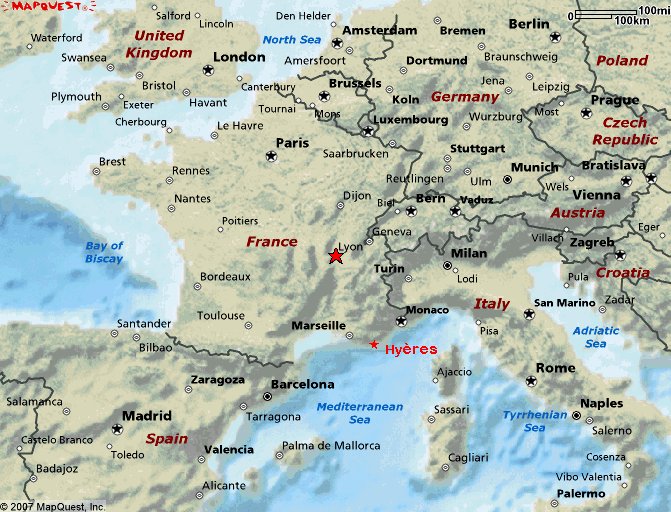
The drive to Lyon trailing a
boat was long, but the roads are good and well sign-posted. The rigour
of the journey was soon forgotten when we reached Lyon and the superb
hospitality of Jacques and his wife, Françoise. Our next 24
hours were spent making final preparations to the boats and trailers.
We were thankful to have Jacques and Françoise lead us out of
the maze of streets in the suburbs of Lyon to our destination of
Hyères (pronounced Yare), which lies to the east of Toulon.
Jacques had reduced the ambitions of his initially planned trip, since
the winds around Marseille tend to be considerably stronger than they
are in the vicinity of Monaco, and had made the decision to start the
trip further east.
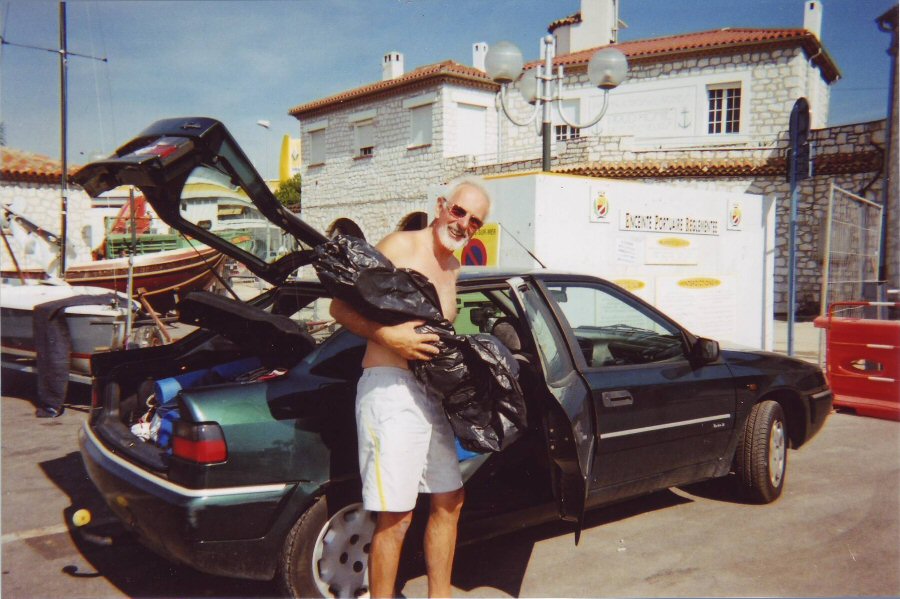
Jacques Boirie with his Wayfarer Merlin Grey in the background. With their easy access to the slipways by car,
the smaller ports like La Capte were ideal for the launching and recovery of the boats.
Day 1
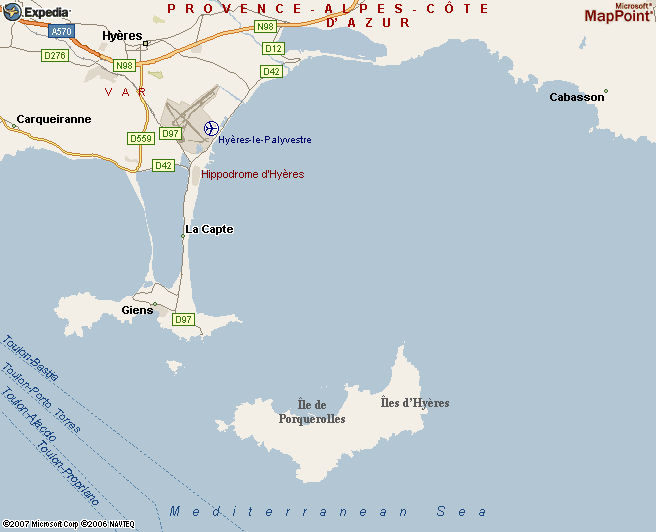
Hyères was a favourite
holiday retreat for Jacques and Françoise, so they knew of an
ideal place we could stay the night, as well as leave our cars and
trailers for the duration of the our trip. With a forecast of very
strong winds for the next few days, it seemed wise to stay within the
vicinity of La Capte – just down the coast from Hyères – which
had a convenient small harbour for launching our boats. The weather was
hot, the wind not always too strong to sail, and the area perfect for
exploring in a dinghy when more moderate winds made sailing possible.
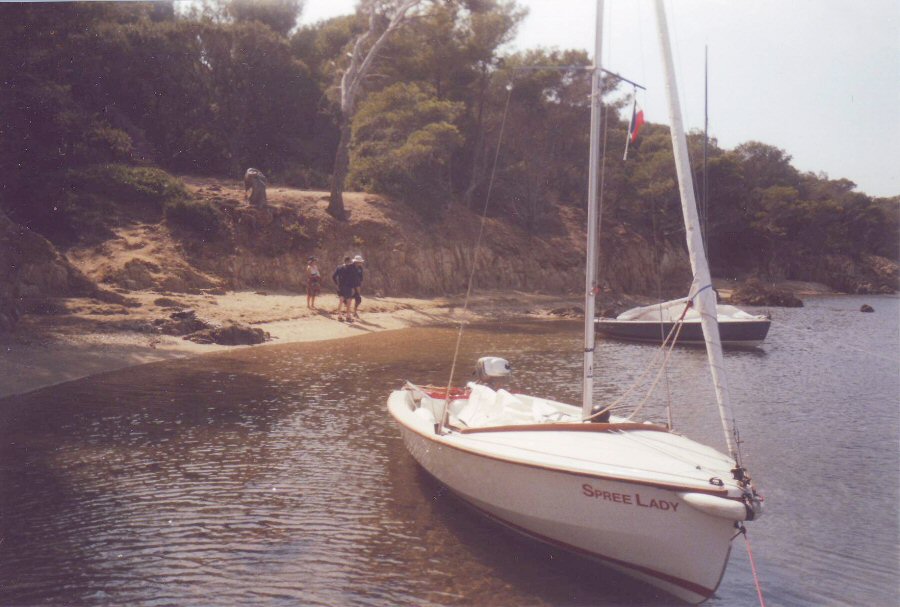
A lunchtime stop near Cap de l’Estérel, at the southern end of the 5km stretch of beach below Hyères. This area offers sheltered sailing in all but an easterly wind, and with its many inlets, coves, islands and rocky shoreline, is ideal for cruising and exploration in a Wayfarer.
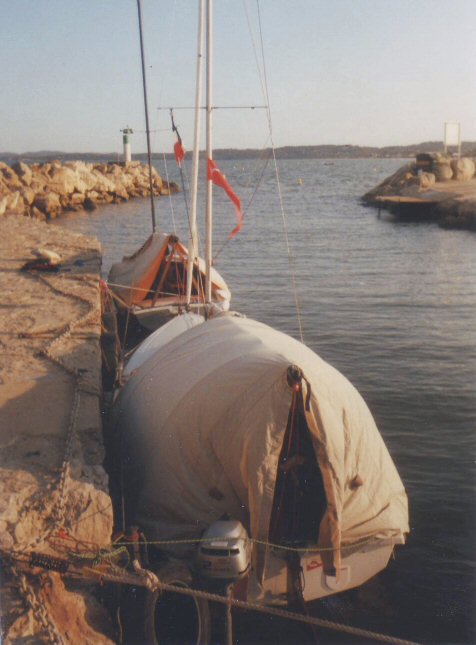
Moored up on the outer harbour wall at La Capte. The main part of the marina is to the right, and no other places
were available during our three-night stay. With the raised outer wall protecting us from the strong winds ,
it was however, as comfortable a place as anywhere in the harbour.
Day 3

We finally started the cruise
two days later than we had originally hoped, setting off as early as we
could, trying to beat the forecast increased wind. However, it was
10:30 by the time we got the boats packed up, and that was not soon
enough. The wind grew steadily stronger as we approached the island of
Porquerolles, and this made the sailing quite demanding, even under
reefed conditions. Having sailed close-hauled to reach the west of the
island, we hugged the northern shoreline for as much protection as
possible and beat our way eastwards towards the bay we had earmarked as
our stopping place for the night.
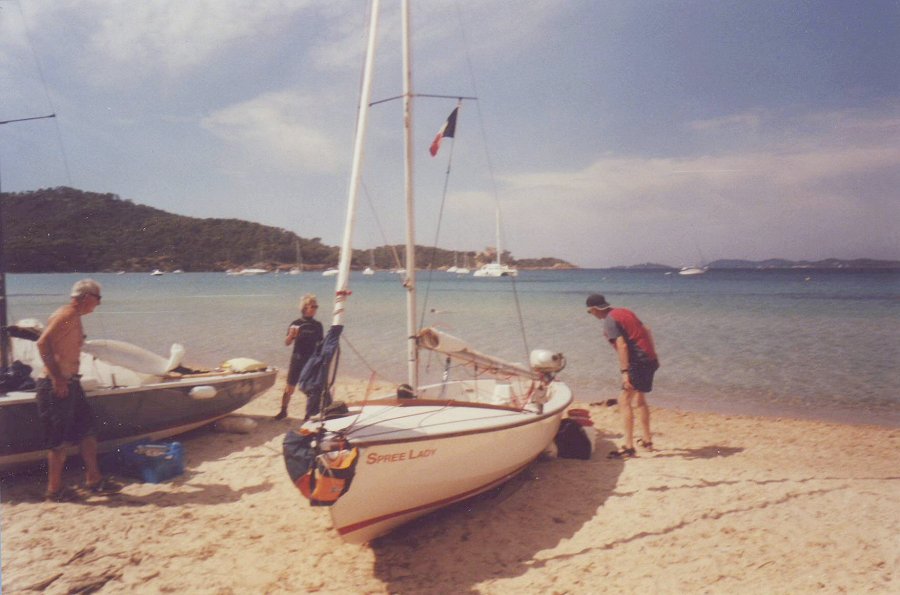
This was one of the few landing places available on Porquerolles. Most of this very beautiful and nationally protected island
has a very rocky and unspoilt coastline, but is small enough to be easily sailed around in less than a day.
Seeing a 470 dinghy pulled up
on the beach, we landed nearby, and were soon in conversation with the
couple using it (unusually) for cruising, rather than racing. They had
been caught by a gust in the strong winds as they had approached the
island and capsized, losing their anchor and a few other items. Looking
over our Wayfarers, they simply drooled over the obvious stability and
amount of space available to carry all the gear required for cruising;
as well as the ease with which a tent could be erected and the
comfortable sleeping area it enclosed. They would have happily swapped
dinghies given half a chance!
Jacques was unaware of any restrictions with regard to sleeping on the boats, which we had rolled up onto the sandy beach, but late in the evening, a shore patrol boat came along to inform us that camping in any form was not allowed on the beach, and we needed to be afloat in order to stay for the night. As this meant anchoring only a few metres off the shore, and involved wading into fairly shallow water to secure a sea anchor, with another dug into the shoreline, it wasn’t too much of an inconvenience. It was more of a problem for the 470 couple, having lost their anchor. They did however manage to persuade the patrol to allow them to camp on the beach for the night in view of their situation, with the promise that they would sail off first thing in the morning.
Jacques was unaware of any restrictions with regard to sleeping on the boats, which we had rolled up onto the sandy beach, but late in the evening, a shore patrol boat came along to inform us that camping in any form was not allowed on the beach, and we needed to be afloat in order to stay for the night. As this meant anchoring only a few metres off the shore, and involved wading into fairly shallow water to secure a sea anchor, with another dug into the shoreline, it wasn’t too much of an inconvenience. It was more of a problem for the 470 couple, having lost their anchor. They did however manage to persuade the patrol to allow them to camp on the beach for the night in view of their situation, with the promise that they would sail off first thing in the morning.
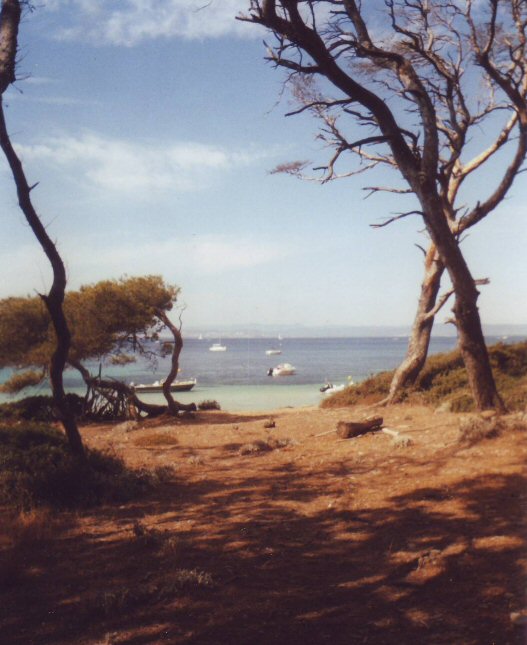
The bay with its sandy beach was a popular mooring place for the local boats. We would have preferred
a less crowded spot, but it looked too difficult to beach the boats at the only other possible landing area.
Day 4
Françoise had planned to
visit a relative the next day, and set off in the morning to catch the
ferry back to the mainland. Jacques’ regular crew, Xavier, was due to
join him in two days’ time at Cavalaire, and he had therefore planned
to sail single-handed to the meeting-up point. In the strong, gusty
wind conditions however, Jacques was happy to swap this role with me,
my boat being better set up for single-handed sailing upwind. Nova
Scotia is about the only coastline I have sailed where the wind
regularly blows from the same direction, and one can cruise, day after
day, in easy, downwind conditions. Pretty much everywhere else involves
periods sailing into the wind, in my experience. And so it was to prove
for virtually the whole of this trip.
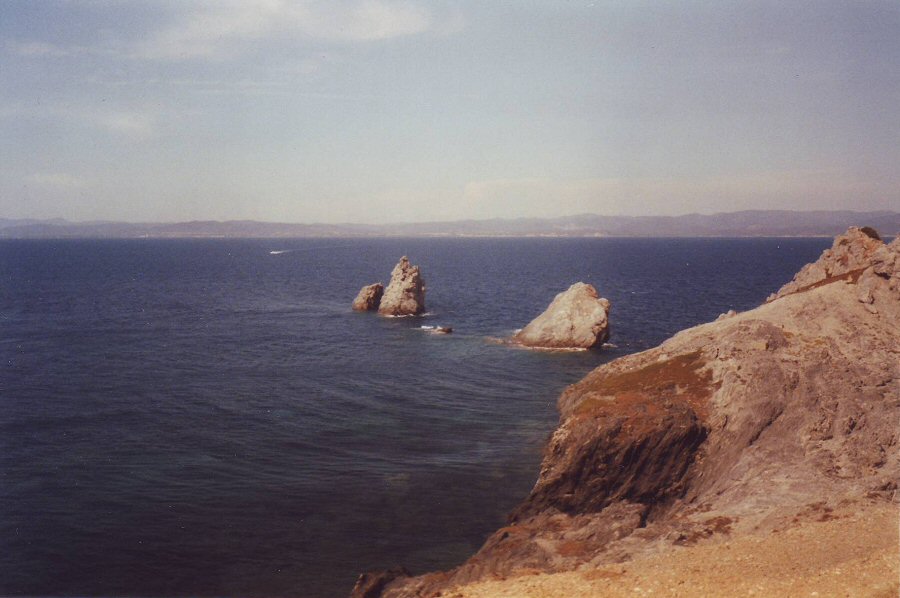
The rocky outcrop of Cap des Medes is the most north-easterly point of Porquerolles.
In the evening, Cedric and I walked the few miles along a well-worn track to this point which is the site of a very old fortification
and observation point, and a popular destination for the many visitors to the island.
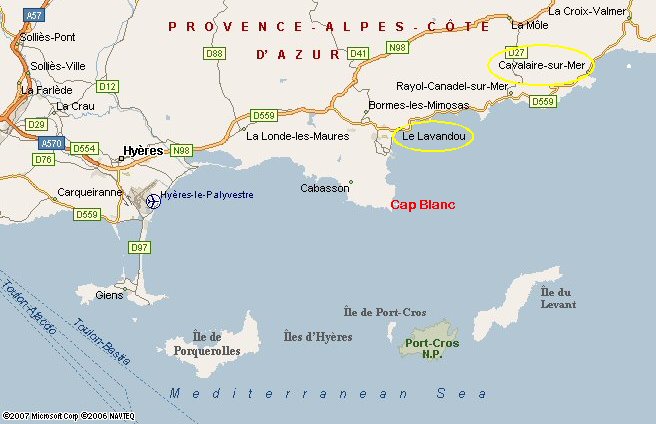
After setting off from
Porquerolles, our initial aim was to make as much headway eastwards as
possible, and to find anywhere suitable to stop along the mainland. In
the event, we were able to sail close-hauled to round the headland of
Cap Blanc, and then ease our sails to reach Le Lavandou, where there
are two large marinas. The first marina looked more plush (and
expensive) than the second, so, being in the lead, I opted to sail the
further distance. It was to prove the only marina we were allowed to
enter under sail, as all the others exercised a strict ‘no sailing’
rule. Personally, I feel much more in control of the boat under sail
than I do with the motor, but only at Le Lavandou were they happy to
watch us sail in – or perhaps it was a look of apprehension!
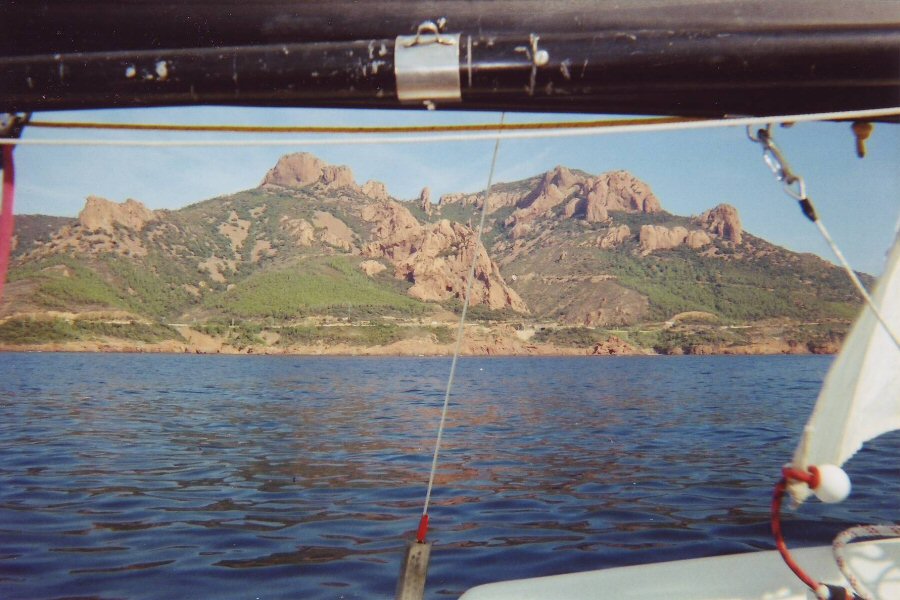
This landscape is typical of the terrain
for this part of the French coast. The main road and rail links run
along the coast
and are never far from the shoreline. This photo was actually taken a little further along the coast,
after the wind had died down a little and all our concentration no longer needed to be on the sailing!
and are never far from the shoreline. This photo was actually taken a little further along the coast,
after the wind had died down a little and all our concentration no longer needed to be on the sailing!
Arriving just before us on the
docking pontoon was a motor yacht sailed by an English couple, John and
Anne Mounrain, who had started their sailing experience in dinghies.
They were immediately interested in our trip, and later invited us
aboard their rather lavish cruiser for an evening meal. Jacques was
just amazed by this interest, though it was something I have often
experienced from the local seafaring people in many countries. They are
always the first to appreciate the seamanship of anyone cruising the
coastline under sail, particularly in an open boat.
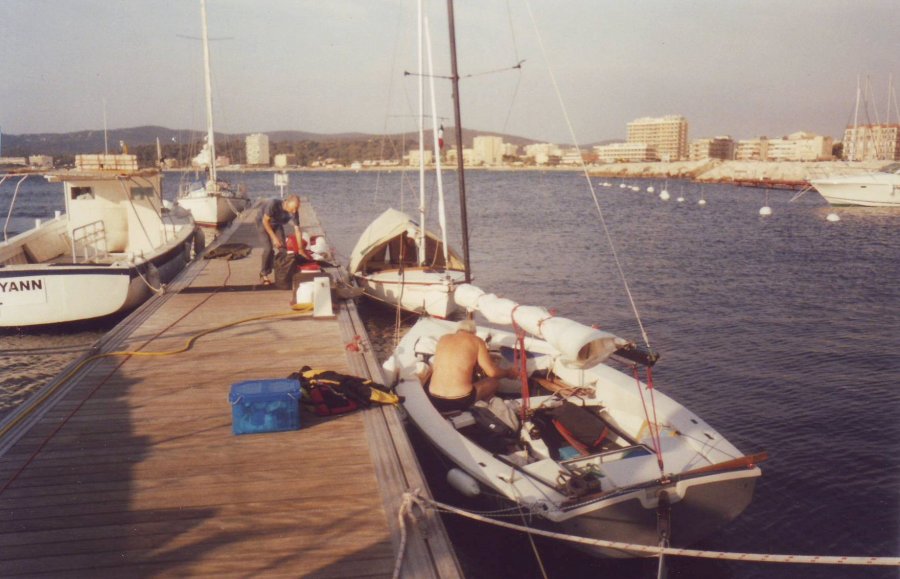
Moored up on the arrival pontoon at Le Lavandou. It didn’t give us any great protection from the strong winds,
but of more concern was the vulnerability of my stern to visiting yachts coming alongside the pontoon.
The greater the amount of shouting from the helm, the greater was my concern!
Day 5
We were initially all right
near the exposed end of the arrival pontoon, but by the next day, the
weather had deteriorated considerably, with gale force winds. And the
forecast for the next two days was for continuing strong winds as well
as periods of rain. We therefore moved the boats to a quieter, more
sheltered spot. I was surprised that the marina was so full, it being
September, but it was to be the same in all the marinas we visited.
Goodness knows where they put all the visiting yachts in July and
August!
Jacques made use of the local
chandlery to carry out some modifications to his boat during our
enforced stay, and the abundant restaurants available were also sampled
for any meals we required. We did carry cooking gear and food, but it
seemed more in keeping with our visitor status to sample the local
ambiance and eat out – it was also a lot easier and more convenient!
The best evening meal of the whole trip though, was the one we shared
with John and Anne. They are a wonderful couple who entertained us
royally, and it was very late when we emerged from the luxury of their
cruiser into gale force winds and pouring rain.
...